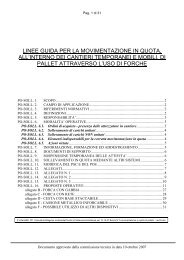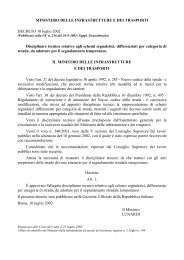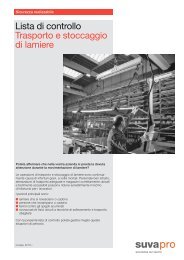Riconquistiamo il paesaggio - ACCA software SpA
Riconquistiamo il paesaggio - ACCA software SpA
Riconquistiamo il paesaggio - ACCA software SpA
Create successful ePaper yourself
Turn your PDF publications into a flip-book with our unique Google optimized e-Paper software.
184<br />
CAPITOLO III - Paesaggi d’Italia<br />
We did not directly measured any relationship among land-use/land-cover changes and biodiversity<br />
patterns over the entire Italy but considering their geographical distribution, the pattern<br />
of changes in land-use/land-cover that we measured show interesting relations to concurrent<br />
and important changes of biodiversity patterns. From 1960 to 2000, the Alps and the Apennines<br />
showed a substantial increase in FOREST, wh<strong>il</strong>e agriculture and human population dropped.<br />
As a result of land abandonment, the floristic species richness is decreasing in higher successional<br />
stages and, depending on the altitude, the structural diversity of the landscape is changing<br />
(Höchtl et al. 2005). In the same time period and in the same area, Italy has experienced a real<br />
“renaissance” of large vertebrates: wolves increased from about 100 individuals in the 1970s<br />
– localized in the central Apennines – to more than 500 individuals in 2000, spreading from the<br />
southern Apennines to the central Alps (Boitani & Ciucci 2000); w<strong>il</strong>d ungulate populations increased<br />
both in numbers and distribution (Boitani et al. 2003); brown bears (Ursus arctos) were<br />
successfully reintroduced in the eastern Alps wh<strong>il</strong>e the central Italy subspecies (U. arctos<br />
marsicanus) has seemingly increased its range (Boitani et al. 2003); temperate forest birds are<br />
following the same pattern, increasing their ranges throughout the mountain areas of the Mediterranean<br />
region (Preiss et al. 1997; Laiolo et al. 2004; Tellini-Florenzano 2004).<br />
Almost the opposite situation can be found in Sardinia, Sic<strong>il</strong>y and in the coastal areas, among the<br />
most important portions of the Mediterranean hotspot for biodiversity conservation (Blondel<br />
& Aronson 1999; Méda<strong>il</strong> & Quézel 1999). Here total agriculture increased (Sardinia) or remained<br />
stable (Sic<strong>il</strong>y and coastal areas), wh<strong>il</strong>e FOREST remained stable (coastal areas) or increased<br />
(Sic<strong>il</strong>y and particularly Sardinia). ARTIFICIAL sharply increased indicating a substantial increase<br />
of human presence, mainly linked to an increase in tourist activities. In Sardinia and the coastal<br />
areas, the drastic decrease of PASTURE followed the decrease in traditional sheep grazing, and<br />
represents an important conservation problem: the little bustard (Tetrax tetrax), a species of<br />
open spaces, is disappearing from continental Italy and its numbers are critically low in Sardinia<br />
(de Juana & Martinez 2001; Wolff et al. 2001); the griffon vulture (Gyps fulvus), dependent on<br />
traditional pasture, has completely disappeared from continental Italy (Dentesani et al. 1996),<br />
and has drastically dropped in number in Sardinia; the Egyptian vulture (Neophron percnopterus)<br />
dropped drastically in number and distribution from 1970 to 1990 following the reduction<br />
of traditional cattle husbandry techniques (Liberatori & Penteriani 2001), typical Mediterranean<br />
bird and plant species, usually restricted to the earlier stages of ecological successions (Blondel<br />
& Farré 1988), are decreasing in range and population sizes, following the decrease of<br />
Mediterranean forests and open areas and the intensification of agriculture (Farina 1991; Farina<br />
1997; Preiss et al. 1997; Brotons et al. 2004).<br />
Even though the Italian landscape is not representative of the entire Mediterranean hotspot<br />
(Vallejo et al. 2005), we suggest that our results may provide an important insight into conservation<br />
planning in the entire region. In fact, many of the ecological and socio-political processes<br />
that have occurred in Italy during the past few decades are already occurring or expected to<br />
occur over most of the Mediterranean region. The transition from traditional to mechanized<br />
agriculture and the intensive development of tourism along the coastal areas are likely to lead<br />
towards situations which are broadly sim<strong>il</strong>ar to Italy today.<br />
Protected areas cannot be eas<strong>il</strong>y adapted to follow these patterns: Italian protected areas already<br />
cover 11% of the territory (Maiorano et al. 2006); most of them are located in mountain<br />
regions (where land-use/land-cover changes favor reforestation and the increase of large vertebrate<br />
populations) wh<strong>il</strong>e only few (mostly small ones) can be found in coastal areas, where<br />
the Mediterranean forest, woodlands and scrubs are concentrated and where human pressure<br />
is high. Much more can be done for the Mediterranean hotspot where protected areas cover





